Building a beautiful dining space really starts with finding that just-right table and chair combo. Plenty of homeowners get stuck choosing between a matching set or mixing pieces that might not work together.
Remember to repin your favorite images!
Honestly, you don’t need a traditional dining set to pull off a cohesive look.
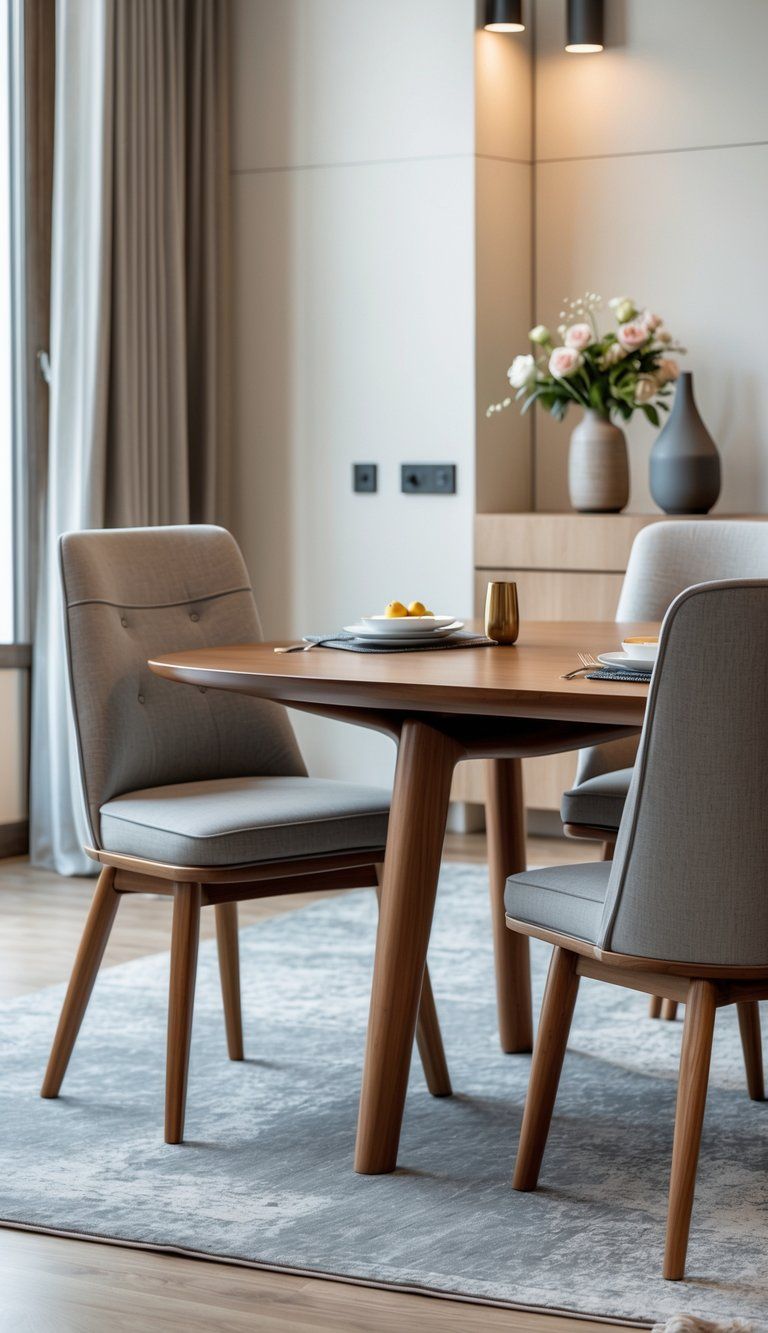
The best dining furniture pairings come down to three things: size, style, and comfort. When you get those right, your dining area isn’t just functional—it actually looks great too. The right combo makes everyday meals more enjoyable and sets the mood for gatherings with family and friends.
Instead of following strict rules, see pairing tables and chairs as a creative adventure. Modern design lets you mix things up and show off your personality. Whether you love French bistro vibes, rustic country charm, or sleek modern style, there’s a pairing out there that’ll transform your dining space.
Understanding Dining Table and Chair Pairings
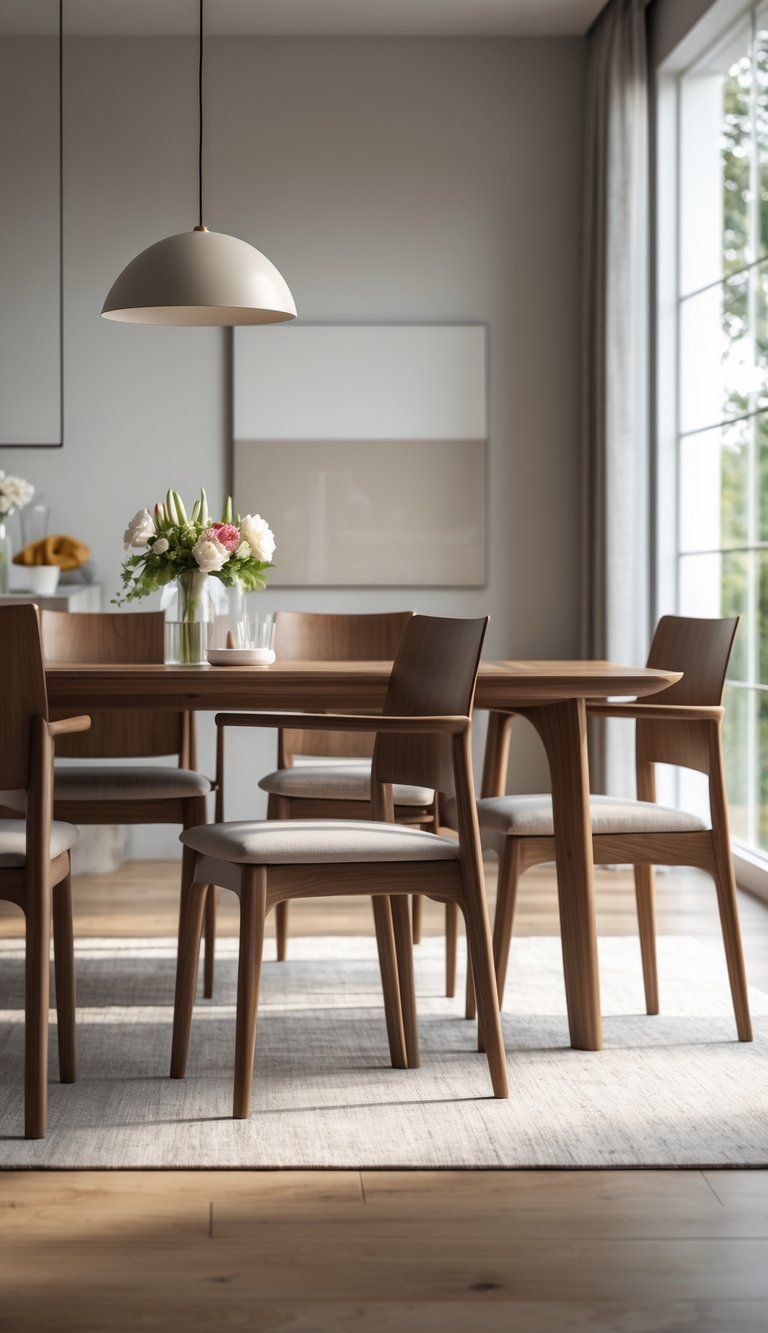
Creating a dining space you love is about more than just grabbing furniture that looks good. The relationship between your table and chairs shapes both how your space looks and how it works.
Why Pairing Matters
When you pair dining tables and chairs well, you create visual harmony. Good pairings make your space feel thoughtful and put-together, not random or thrown together. A well-matched set can even make the room look professionally designed.
The right pairing sets the tone for your dining room. A sleek glass table with chrome-legged chairs screams modern, while a rustic wooden table with soft fabric chairs gives off a farmhouse or traditional vibe.
Pairings also change how your space functions. Oversized chairs crowd a small table, and tiny chairs at a huge table look off. When you strike the right balance, your dining area feels comfortable for daily meals and entertaining.
The Role of Comfort and Functionality
Never sacrifice comfort for style. Your dining chairs need to support your posture and feel good enough for those long, lingering dinners. Look for chairs with proper back support and just the right amount of cushioning.
Think about who’ll use the space. Families with kids might want tough, easy-to-clean chairs. If you love hosting, you might care more about elegant, cushy options.
Chair and table height matter a lot. Standard dining tables are 30 inches high, so you’ll want chairs with seat heights around 18 inches. That gives most adults about a foot of space between the seat and the table—pretty much ideal.
Check that chairs with arms fit under your table, and make sure you can push all the chairs in completely. That little detail makes a big difference.
Overview of Dining Room Furniture Types
Dining tables come in all sorts of shapes and materials. Round tables are great for small spaces and make conversation easy. Rectangular tables fit more people and work best in long rooms. Square tables look modern and suit square dining areas.
Materials change the feel and upkeep. Glass-top tables feel light and modern but show fingerprints. Solid wood is warm and durable, though it might need more care. Metal bases give an industrial vibe, and marble tops add a touch of luxury.
Chairs are just as varied. Side chairs without arms save space, while armchairs bring extra comfort. Upholstered chairs are plush but need more cleaning than wood. Benches can sit on one side of the table for a casual, modern twist.
Mixing and matching is more popular than ever. Use host chairs at the table ends and simpler side chairs along the sides, or try different chair styles in colors that play well together for an eclectic, yet put-together look.
Essential Principles of Interior Design for Dining Areas
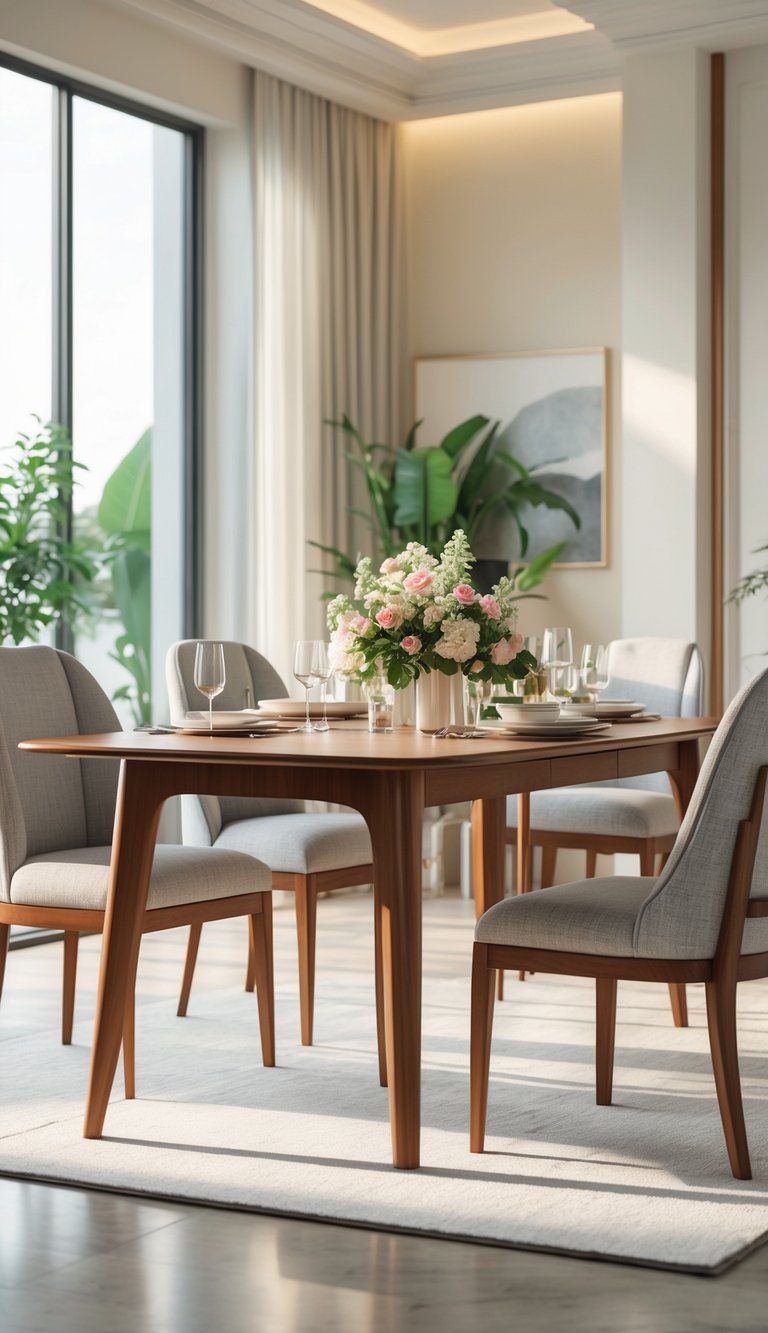
Designing a beautiful dining space means balancing style with function. A few key principles can help you pull off a space that’s both practical and inviting.
Balancing Proportion and Scale
Proportion and scale really matter in dining rooms. Your table should fit the space—leave at least 36 inches between the table and walls or other furniture. If you squeeze in a huge table, the room feels cramped. Go too small, and the table looks lost.
For chairs, plan for about 24 inches of width per person. That way, everyone sits comfortably without bumping elbows. Table height is usually 30 inches, so chairs should leave about 10-12 inches between the seat and the tabletop.
Lighting matters too. Hang a chandelier about 30-36 inches above the table in rooms with 8-foot ceilings. If your ceilings are higher, add 3 inches for each extra foot.
Choosing Complementary Materials and Finishes
Materials and finishes set the mood for your dining area. You don’t have to match everything, but complementary choices help tie the space together.
Material Pairings That Work:
- Wood table with upholstered chairs
- Glass table with metal or wood chairs
- Marble table with velvet or leather seating
Mixing textures keeps things interesting. Try a smooth table with chairs that have textured upholstery or details.
If you have kids or messy eaters, pick stain-resistant fabrics and tables with tough finishes. Natural materials like wood gain character over time, while manufactured materials hold their look longer.
Creating Visual Harmony in Dining Spaces
Visual harmony can turn an average dining area into something special. Start with a focal point—maybe a cool chandelier, bold art, or a dramatic table.
Color matters a lot. Try the 60-30-10 rule:
- 60% dominant color (like walls or big furniture)
- 30% secondary color (some furniture or curtains)
- 10% accent color (art or accessories)
Lighting isn’t just practical—it’s part of the design. Layer it with:
- Ambient lighting for the whole room
- Task lighting aimed at the table
- Accent lighting for artwork or architectural features
Balance symmetrical elements, like matching chairs, with a few off-center touches—maybe an art piece that’s just a little askew. It keeps things lively without making the space feel chaotic.
Selecting the Perfect Dining Table
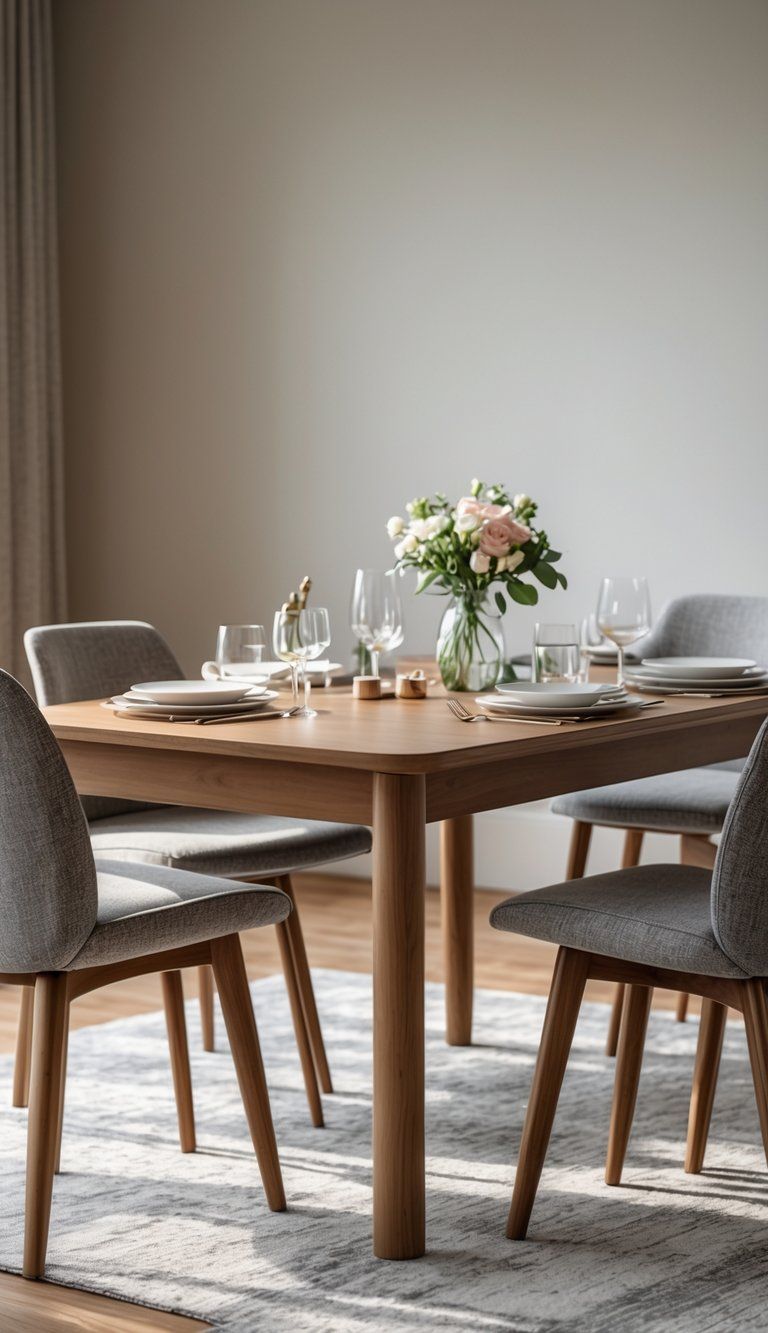
Your dining table is really the heart of your space. It sets the mood for everything from daily meals to big gatherings.
Popular Shapes: Round, Oval, and Rectangular
Round tables make dining feel cozy and encourage conversation. They’re great for smaller spaces and square rooms, plus, no sharp corners to bump into.
Oval tables have that same cozy vibe but squeeze in more people. They fit nicely in rectangular rooms and keep things flowing. Many come with extension leaves, which is handy for entertaining.
Rectangular tables are the go-to for most people. They work well in long rooms and seat more guests. For example, a 72″ rectangular table seats six, while a 96″ table fits up to ten.
Before picking a shape, think about your room’s dimensions. A rectangular table in a square room can feel weird, and a round table in a narrow space wastes space.
Material and Construction: Solid Wood and More
Solid wood tables are classic for a reason. Oak, maple, walnut, and cherry all have their own look and just get better with age.
Wood veneer tables give you the look of solid wood for less money. Good veneers are stable and resist warping, though you can’t refinish them as many times.
Other materials worth considering:
- Glass: Makes small spaces feel bigger and brighter
- Stone or concrete: Super durable and industrial-chic
- Metal: Modern, often mixed with wood or glass
Check construction details. Look for corner blocks, dowels, and screws—not just glue. A sturdy table won’t wobble when you lean on it.
Assessing the Right Size for Your Space
Your table needs space for chairs and movement. Leave at least 36″ between the table and any walls or furniture. If it’s a busy area, go for 48″.
To figure out your ideal table size:
- Measure your dining area
- Subtract 6 feet (3 feet on each side) from both length and width
- That’s your max table size
For seating, plan on 24″ of table edge per person. A 72″ table seats six, and a 96″ table fits eight to ten.
If you only host big groups occasionally, an extendable table could be perfect. You get flexibility without taking up space every day.
Choosing Ideal Dining Chairs
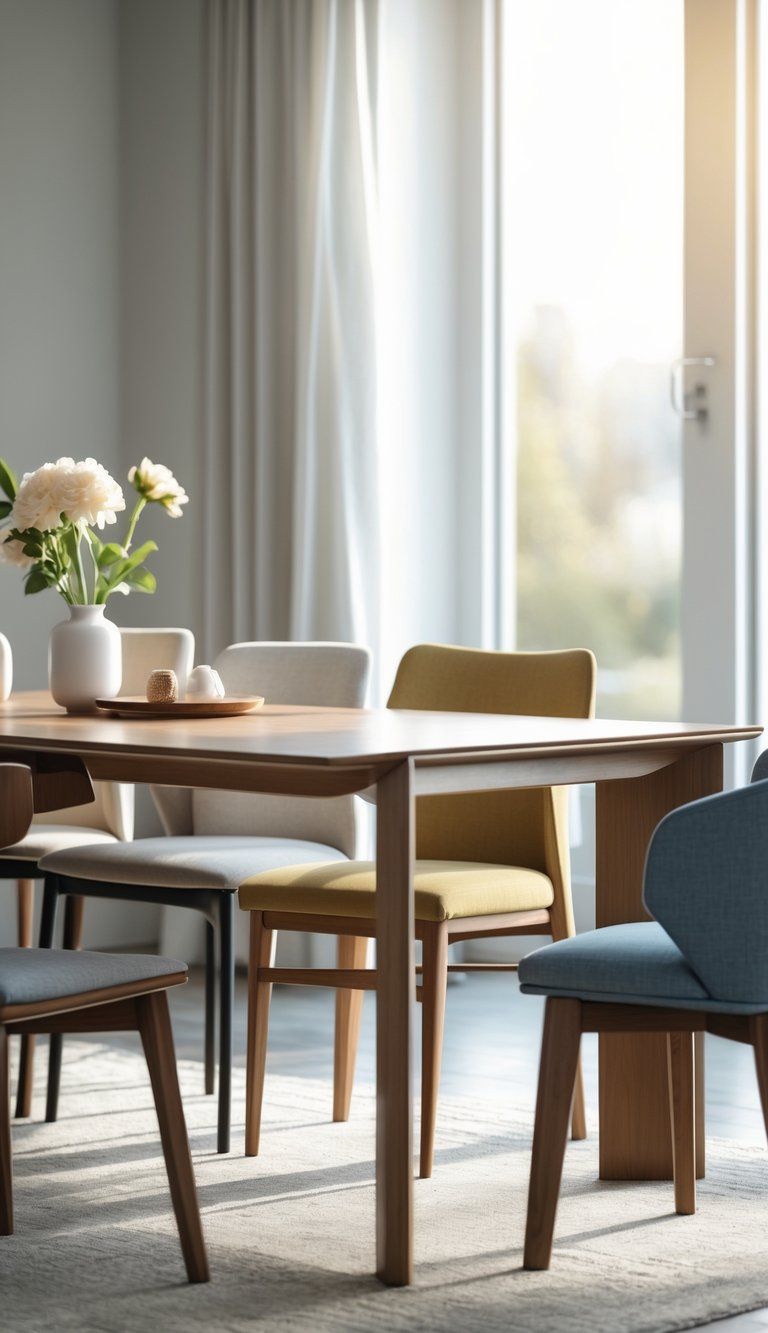
Picking the right dining chairs changes both the comfort and the style of your dining space. The perfect chair strikes a balance between looks, comfort, and durability, and it should play nicely with your table and room decor.
Chair Styles and Ergonomics
When you’re choosing chairs, think about both style and how they feel. Traditional chairs with arms offer support but take up more room. Armless chairs are flexible and let you squeeze in more people.
Standard seat height is 18-20 inches, which lines up with most tables that are 28-30 inches tall. Aim for 10-12 inches between the seat and the tabletop for comfy legroom.
Chairs with slightly angled backs (100-110 degrees) offer better posture support. A contoured seat is way more comfortable than a flat one, especially for long dinners.
Try to test chairs in person if you can. Sit for at least 5 minutes—your feet should touch the floor, and your back should feel supported.
Upholstery, Materials, and Finishes
Chair materials affect both how long they last and how they look. Wood is always in style and super sturdy. Popular options:
- Oak: Tough, with a visible grain
- Walnut: Rich and dark
- Maple: Light and clean-looking
Metal chairs bring a modern, industrial feel and are easy to wipe down. Powder-coated finishes last longer.
For upholstery, weigh comfort against practicality. Leather and vinyl wipe clean and are durable. Fabric feels cozy and comes in tons of styles, but it can stain. Performance fabrics like Sunbrella are great for resisting spills and fading.
If you have kids, go for stain-resistant materials or washable covers. The right finish should match your table and hold up to daily use.
Mix-and-Match vs. Coordinated Sets
Matching sets are classic, but mixing chair styles adds personality. If you mix, keep something consistent—color, material, or height.
One fun approach is using different chair shapes with the same finish or fabric. Or, try the same chair in different colors for a coordinated but playful vibe.
Head chairs at the ends of the table can differ from side chairs for a designer touch. Try larger or upholstered chairs at the ends, with simpler ones along the sides.
For round tables, identical chairs usually work best. Rectangular tables let you mix it up more.
Your chairs don’t have to match the table exactly. Sometimes, complementary pieces make a space more interesting than a perfect match. Focus on balance, not symmetry.
Achieving the Perfect Pair: Tables and Chairs
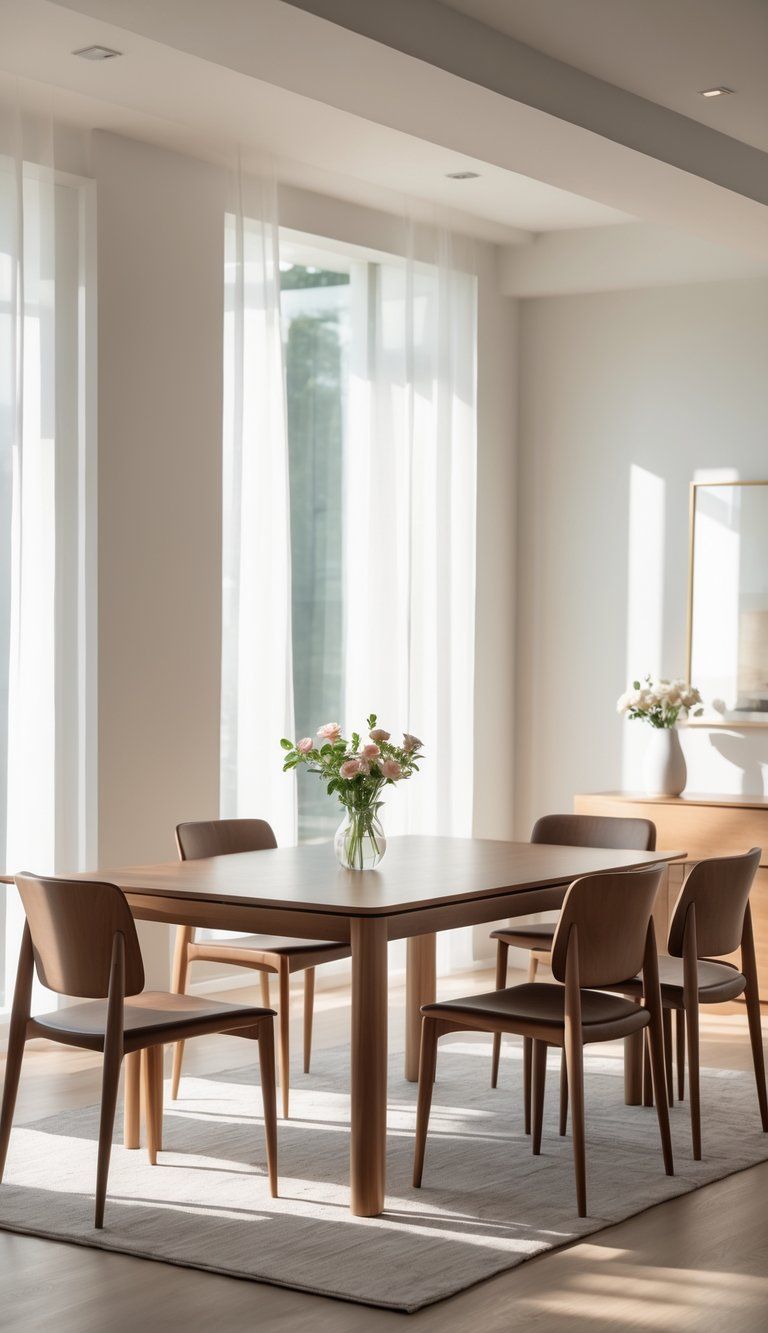
Pairing your dining table and chairs is part art, part science. The right combo boosts your dining area’s function and lets your personal style shine through.
Proportion and Seat Height Guidelines
Getting the proportions right between tables and chairs really changes the whole dining experience. Most dining tables stand around 30 inches high, while chair seats usually sit 18-20 inches above the floor.
That gap—10 to 12 inches between the seat and table—makes dining way more comfortable.
If you’re using arm chairs, make sure you’ve got at least 7 inches of clearance between the chair arm and the underside of the table. That way, guests can slide in without bumping their elbows or feeling squished.
Table shape matters more than people think. Round tables look fantastic with curved-back chairs that mimic their lines. Rectangular tables? You can pair them with almost any style, but straight-lined chairs always look sharp.
Give each person about 24 inches of width for comfortable seating. In smaller spaces, armless chairs or benches that tuck fully under the table become lifesavers.
Blending Colors and Textures
Mixing up materials instantly adds personality to your dining space. Maybe you’ll pair a solid wood table with plush, upholstered chairs for a cozy, balanced vibe.
Don’t stress about matching colors exactly. Instead, look for shades that play nicely together within your color scheme. A walnut table could work with similar tones or really pop against painted chairs in blue or green.
Texture matters, too. Try these combos:
- Sleek glass table + woven rattan chairs
- Rustic wood table + smooth leather seating
- Marble tabletop + velvet upholstered chairs
If you’ve got kids (or just messy eaters), you might want wipeable leather or washable fabrics. That little bit of practicality goes a long way.
Adapting to Various Design Themes
Modern dining rooms thrive on clean-lined tables and sculptural chairs that double as art. Mid-century classics or bold contemporary silhouettes really stand out.
Traditional spaces love matched sets. A pedestal table with turned-leg chairs and carved details always feels timeless.
Farmhouse or rustic themes invite you to mix things up. Try different chair styles painted the same color for an eclectic but unified look.
Coastal rooms lean toward light woods and breezy materials. Picture a whitewashed table with blue chairs or natural seagrass seats—super beachy.
In tight quarters, transparent acrylic chairs keep things airy without sacrificing comfort or style.
Styling and Decorating Your Dining Set
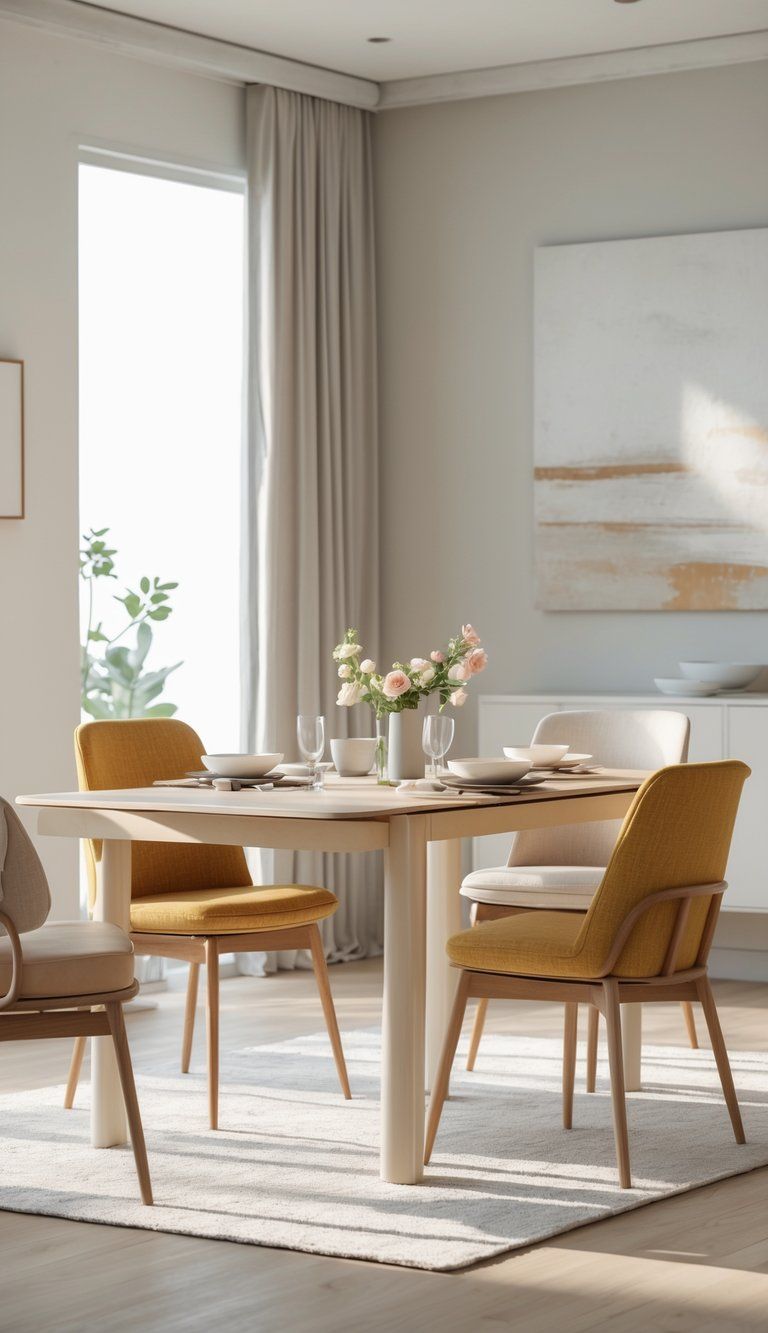
Crafting a beautiful dining area isn’t just about picking a table and chairs. The little details you add bring out the warmth and personality that make the space inviting.
Incorporating Dining Table Decor
Think of your dining table as a canvas for self-expression. For everyday meals, a simple centerpiece works wonders. Maybe a low vase with fresh flowers, a bowl of fruit, or a few candles at different heights to keep things lively but not fussy.
Try the Rule of Three—grouping decor in threes just feels right. A vase, a candle, and a bowl can balance each other out without clutter.
Switch up your decor with the seasons. Fall leaves and pumpkins in autumn, pinecones in winter, bright blooms in spring—easy ways to keep things feeling new and festive.
Table runners or placemats that echo your chair upholstery or color palette add texture and protect your table. Plus, they’re just nice to have.
Using Accent and Side Tables for Cohesion
Accent tables pull double duty in the dining room. A sideboard or buffet against the wall gives you extra storage and a spot to display decorative items or serve food.
When you pick accent tables, look for pieces that fit your dining set’s vibe, but don’t match too closely. If your table’s modern, a sideboard with clean lines but a different finish adds interest.
Use side tables for:
- Stashing extra dishes or linens
- Showing off art or family photos
- Setting out food and drinks for guests
- Balancing the room’s layout
Try to keep accent tables just a bit lower than your dining table. This creates a nice visual line around the room.
Lighting and Accessorizing the Dining Room
Lighting can make or break your dining room’s mood. Hang a statement pendant or chandelier right above the table to draw the eye and set the tone.
Layer your lighting:
- Ambient: Main ceiling fixture
- Task: Wall sconces or buffet lamps
- Accent: Table lamps or candles
Hang your pendant 30-36 inches above the table so it lights things up without blocking conversation.
A rug under the dining set defines the area and adds coziness. Pick one at least 24 inches wider than the table on all sides so chairs stay on the rug, even when pulled out.
Mirrors and art on the walls bounce light around and show off your style. Pick pieces that fit your dining set’s look, but don’t let them steal the spotlight from your guests.
Pairing Ideas for Different Dining Room Styles
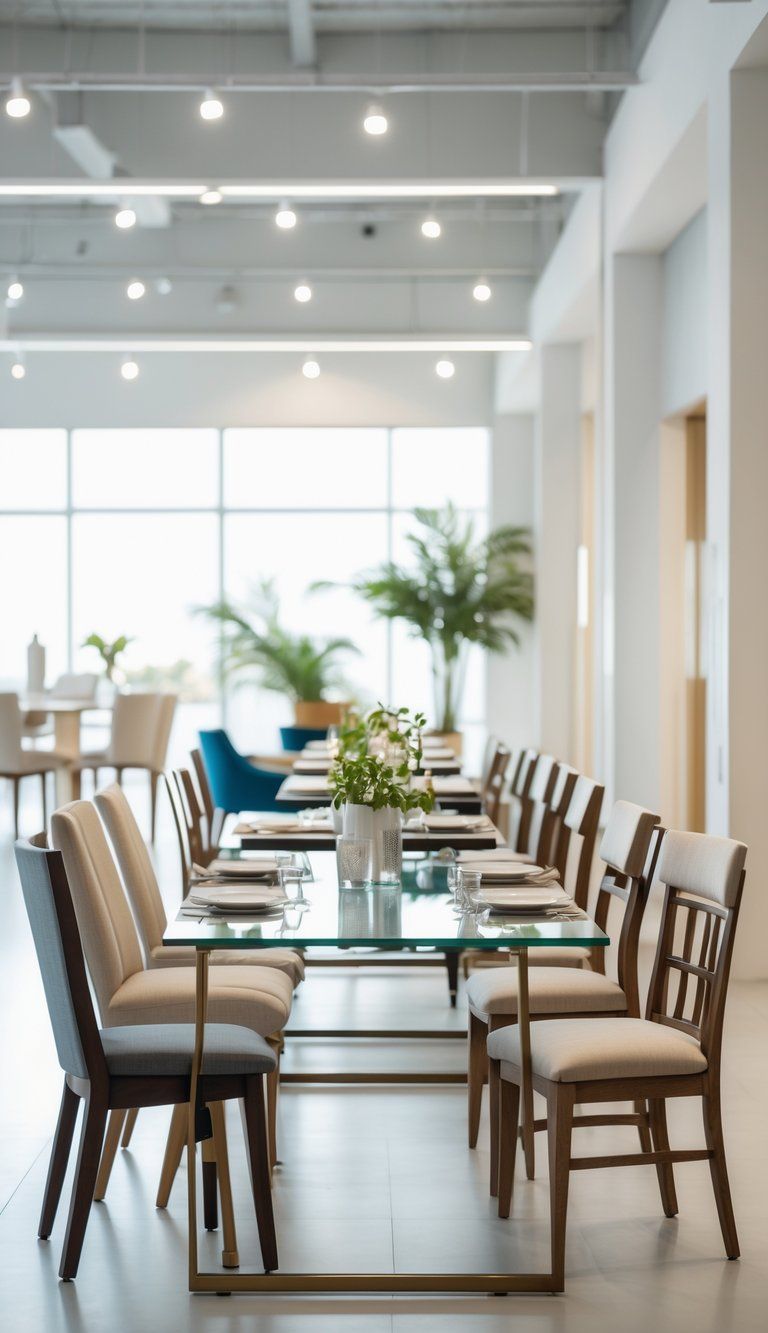
Finding the right combo of dining tables and chairs can totally change the feel of your eating space. The style you pick sets the mood for every meal and gathering.
Traditional Dining Room Inspirations
Traditional dining rooms usually show off rich wood tables with elegant details. Try a mahogany or cherry table with upholstered seats and curved-back chairs.
Chairs with cabriole legs or Queen Anne curves look great with a formal table. You can match all your chairs for a classic look, or mix it up by using different ones at the ends.
Classic Combos:
- Round pedestal table + shield-back chairs
- Rectangular, carved table + wingback end chairs
- Oval cherry table + ladder-back chairs with cushions
Choose damask, subtle stripes, or rich solid fabrics for your seats to complement the wood.
Modern and Contemporary Pairings
Modern dining rooms love clean lines and simple shapes. Glass, light wood, or metal-base tables team up well with sleek chairs.
Mixing materials keeps things interesting. Maybe a concrete-top table with molded plastic chairs, or a glass table paired with leather seats. Just make sure there’s a comfy 7-12 inches between the chair seat and table underside.
Popular Modern Pairings:
- Marble-topped table + simple black chairs
- Glass table + molded plastic chairs in bold colors
- Natural-edge wood slab + industrial metal chairs
Don’t shy away from color. A neutral table lets you go wild with colorful seating.
Eclectic and Transitional Approaches
Eclectic dining rooms really show off your personality by mixing things up on purpose. You can use chairs of different styles, as long as they’re similar in height and scale.
Try putting big “host” chairs at the ends and lighter chairs down the sides. Windsor-style chairs look surprisingly good with modern tables, and bentwood chairs warm up sleek surfaces.
Mix-and-Match Ideas That Work:
- Farmhouse table + painted wooden chairs in different shapes
- Industrial table + both upholstered and metal chairs
- Mid-century table + chairs in different (but coordinating) styles
Of course, comfort matters. Even the best-looking chair needs to be nice to sit in for long meals.
Maximizing Small and Large Dining Room Spaces
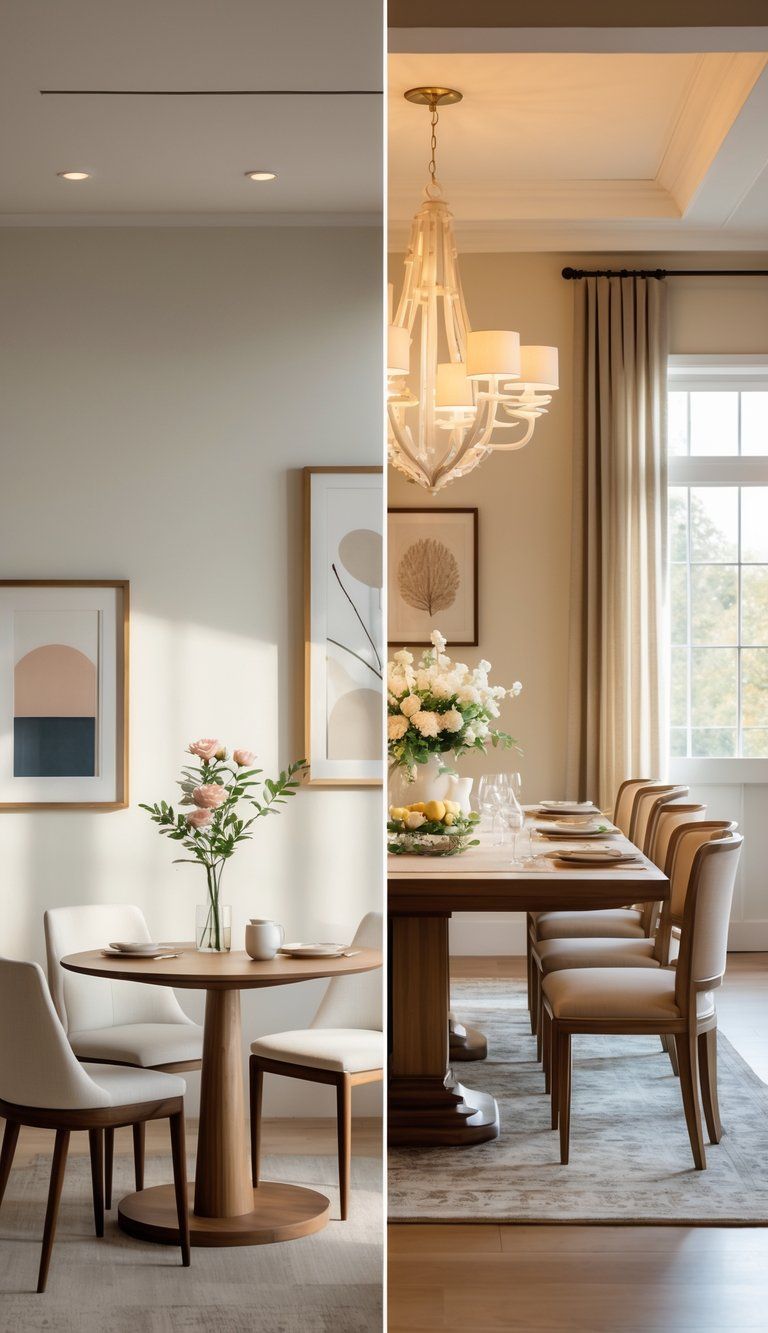
Your dining room’s size really shapes your options. Smart planning helps tiny spaces work harder, while big rooms need careful arranging to avoid that empty, echoey feel.
Smart Layouts for Compact Rooms
In small dining rooms, every inch is precious. Go for low-profile, armless chairs you can tuck all the way in. This keeps the space feeling open.
Round tables are a game changer in tight spots. No sharp corners means guests can move around more easily.
If you’re really tight on space, try a drop-leaf table that expands only when you need it. Always leave at least 36 inches between the table and walls or furniture so people can get by.
Built-in banquettes along a wall can fit more people without hogging floor space.
Grand Arrangements for Spacious Areas
Big dining rooms (think 14×14 feet or more) can handle bold choices. Rectangular tables look great in long rooms, while big round tables feel welcoming in square spaces.
If you entertain a lot, go for a table that seats eight or more. Hosts usually sit at the ends of rectangular tables, which naturally draws focus.
Add a buffet or credenza to one wall to break up the space and provide storage. This helps balance out the room visually.
Larger chairs with arms look right at home in big rooms. Just check that the arms fit under the table for a tidy look.
A big rug—at least 24 inches wider than the table on each side—grounds the space and keeps things cozy.
Beyond the Dining Room: Complementary Furniture Choices
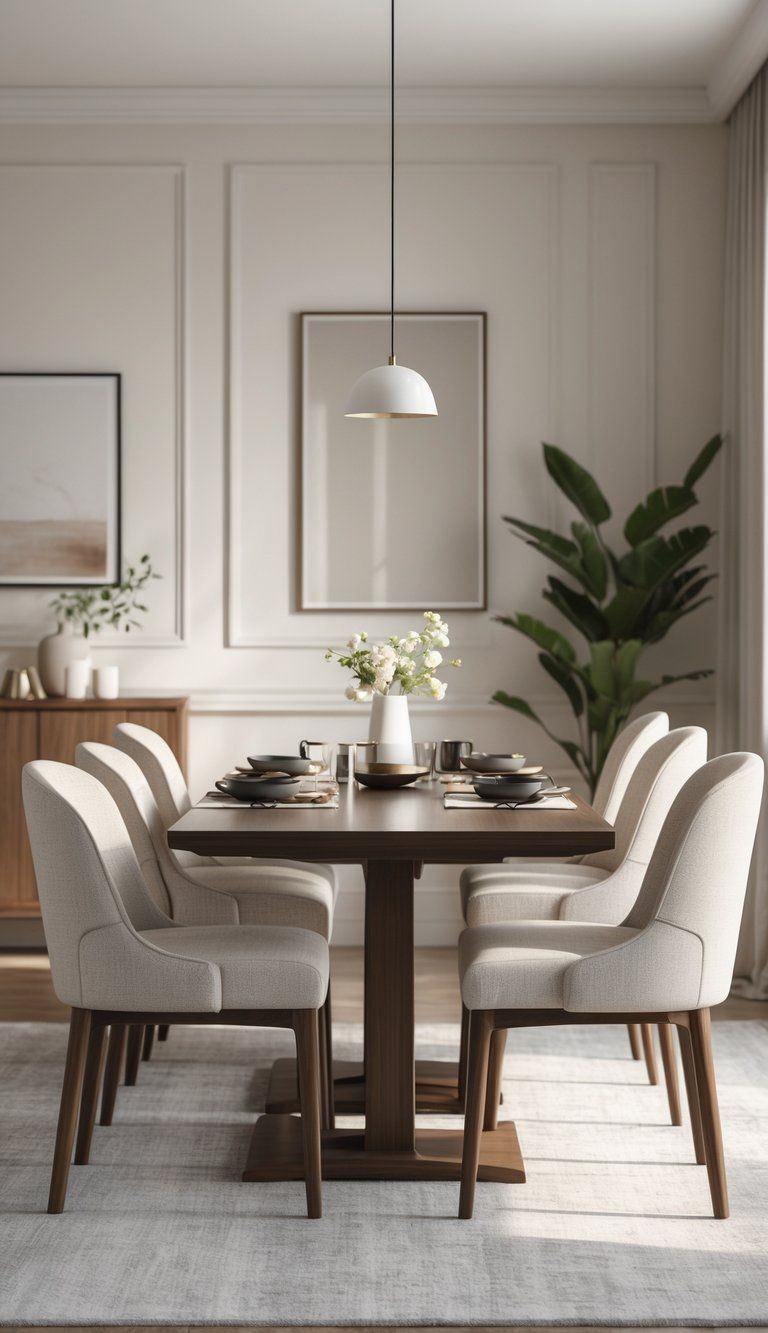
Your furniture choices don’t stop at the dining room. Creating a cohesive home means thinking about how each piece connects with the others, even in different rooms.
Integrating Nightstands and Bedside Tables
Nightstands do more than just hold your alarm clock. They should work with your bed frame and the whole bedroom vibe.
In modern bedrooms, try minimalist platform beds with sleek, floating nightstands. This keeps things airy and uncluttered.
Traditional bedrooms look best with matching wooden nightstands that have drawers. Stick to similar wood tones and hardware for a pulled-together look.
Don’t feel like you have to use identical tables on both sides. Different heights and styles can look great if they share a common color or material.
Think about function, too. If you love reading in bed, pick a nightstand tall enough for your lamp to be at eye level. Most bedside tables work best at or just above mattress height.
Choosing Accent Pieces for a Cohesive Look
Accent tables can really pull a room together, and they add some handy function too. You want them to complement your other furniture, not steal the spotlight.
When you’re picking out side tables for the living room, think about size. If you have a big, chunky sofa, you’ll want accent tables that have some heft to them.
On the other hand, lighter seating feels right with smaller, more delicate tables. It’s all about balance, right?
Materials play a big role in whether your space feels cohesive. Let’s say your coffee table uses glass and metal—try to echo those materials in your accent tables for a more pulled-together vibe.
Stick to your room’s color palette when you’re adding decor on top of these tables. I usually group items in odd numbers (like 3 or 5); it just looks more interesting that way.
And hey, don’t forget nesting tables. They give you flexibility when you have guests and hardly take up any room when you tuck them away.
They’re a smart pick, especially if you’re working with a smaller home or apartment.

